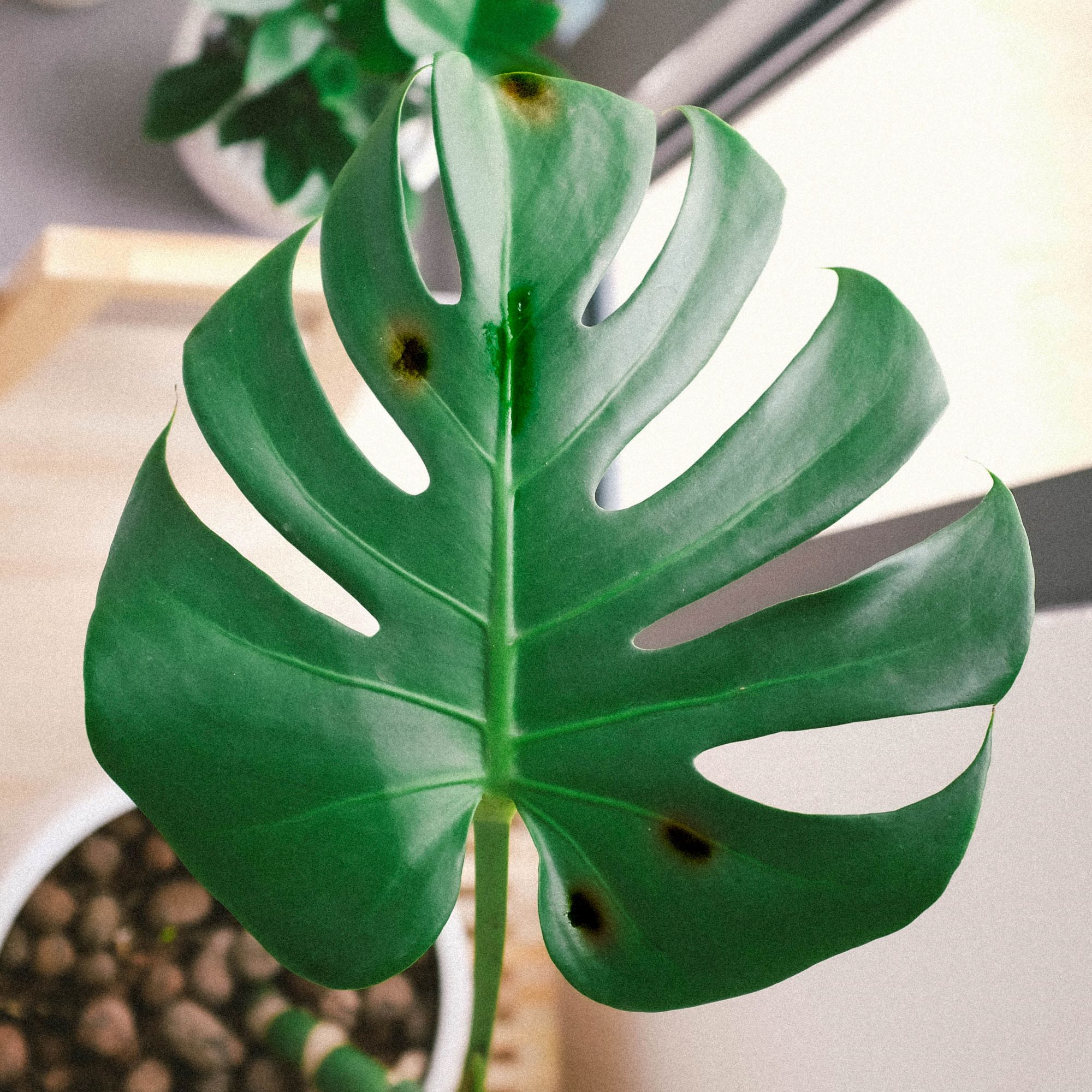Sick plant? This guide will help you diagnose black or brown leaves on your Monstera Deliciosa. Leaf damage can have many possible causes. Figuring out the reason for your Monstera’s black leaves will help you return your plant to health faster!
This guide is for black spots on existing Monstera leaves — check out this article (coming soon) instead for help with black spots on new growth or new leaves unfurling black.
Table of Contents
Black spots on Monstera leaves
Black or brown spots on Monstera leaves occur when leaf tissue dies. Based on the color, texture, and location of the spots, we can determine what is wrong with your Monstera.
Overwatering
To begin with, the most common type of black spot on Monstera leaves is caused by overwatering. Overwatering damage appears as dark brown or black patches of varying sizes at the edge or middle of the leaf. Often, the spots yellow around the edges, and feel soft when touched. Overwatered leaves curl as well.
Additionally, if your Monstera shows symptoms of overwatering, it is important for you to check the stem and roots for black mushy areas as soon as possible. Root and stem rot is the number one killer of Monstera houseplants.
Our Monstera watering guide can help you adjust your watering habits. Check out this guide for picking the best pot for your Monstera to ensure good soil moisture.
Dehydration
When your Monstera lacks moisture, leaves may form spots at the tips and edges. Similar to overwatering, leaves appear limp or curling. Unlike overwatering, dehydration damage causes leaves to turn lighter brown and crispy from the outside in. This is the easiest way to tell the causes apart.
Underwatering, low humidity, or a combination of both contribute to dehydration damage. Try increasing watering frequency or amount. You can also use a humidifier to increase humidity in your home if you live in a dry climate or have the heat on in the winter. See our humidity guide.
Sunburn on Monstera leaves
Monstera leaves can turn black if they become burnt. Black or brown spots from sunburn appear dry and occur on the upper surfaces of leaves nearest the light. A silvery grey or bleached tint to the leaves provides the telltale indicator of sunburn.

Sunburn can occur due to direct sunlight from a window, or placing your plant too close to a grow light. Monsteras grow naturally in shade, so the heat from direct sun is too much for them unless they are carefully acclimated. Learn more about the best Monstera light conditions in our guide.
Move your plants further away from damaging light sources, provide indirect sunlight only, and never take your Monstera outside to sunbathe. If your plant needs more light, check out our best grow lights for Monstera guide.
Frost Damage
Because they are tropical plants, Monstera should never be left outdoors in the winter in cold climates. As a result, houseplant Monsteras are mostly likely to encounter cold damage during transportation or shipping. If your Monstera is exposed to freezing temperatures in your home accidentally, get it back into the warmth as soon as possible.
Frost damage is devastating; any part of the plant that freezes through will die as its cells burst. Frozen leaves and stems will turn black or brown, appear burned at first, and may become soggy. The consequences of cold damage can take several days to fully appear.
Mechanical Damage
Monstera leaves that experience damage to their physical structure sometimes turn black. To check for this issue, inspect your leaves for any rips or tears that could cause the tissue to die. Black spots from mechanical damage will be confined to the torn areas, and do not pose a risk for the rest of the plant.
Splits that are present when a Monstera leaf unfurls are different than rips or tears. Learn more about Monstera leaf splits.
Fungus or Pests on Monstera leaves
Bacterial or fungal leaf spots appear as small, brown, wet circles with yellow surrounding them, usually all the same size. In my experience, Monstera spots are overdiagnosed as being fungal in origin when the problem is often overwatering or some other pest.
Some sources claim that you should never get Monstera leaves wet as it will cause fungus. This is not technically true; plants get wet all the time in nature with no negative effects. The truth is that water on leaves can spread fungus that is already present. If your Monstera or nearby plant is infected with a fungal disease, water droplets running down the leaves can spread the spores.
Common Monstera pests such as thrips or spider mites that suck the juice from the leaves can also cause small brown or yellow spots. If your Monstera has pests, it needs an insecticide treatment in order to recover.
Go to the next article to find out what to do with damaged or black leaves on your Monstera.
Want to use what we use for our Monstera plants? Check out our Monstera care product recommendations that you can purchase from Amazon.
